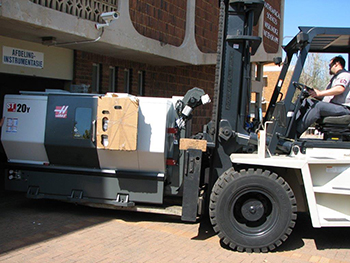Machinery and equipment to the value of R6 million acquired by UFS Instrumentation Division

Photo: Supplied |
At an information session held on the Bloemfontein Campus, the Instrumentation Division in the Faculty of Natural and Agricultural Sciences at the University of the Free State (UFS) introduced its new Computer Numeral Control (CNC) machines to the value of R6 million.
Initially, the primary aim of the Instrumentation workshop was to design, produce, and maintain special research equipment which is unavailable on the market, mainly for academic departments. The small-scale production focused on producing support material and equipment for research work.
However, with new equipment and machinery the Division now also can deliver a service to corporate companies and external associates.
The CNC machines include a 5-axis Vertical Machining Centre from Haas imported from America. This is one of only four in South Africa, with two in Johannesburg and one in Cape Town. The lathe makes it possible to produce sophisticated parts, which were previously cumbersome and difficult to make. The machines also cover a wide spectrum in the mechanical field such as the the FLOW Water Jet, which cuts a wide variety of material ranging from titanium to wood without utilising heat, thus saving electricity. This makes it possible to cut a wide variety of materials.
With the new machinery now available, the Instrumentation Division is able to perform high quality and quantity production with precision.
“The advantage of the machinery is that it stimulates production, and is much faster and more accurate than the conventional way of doing things,” said Pieter Botes, Head of the Division.
Botes explained that, by having students and professional artisans at the university design and manufacture equipment, costs are reduced when compared with the expensive nature of equipment and tools found in the market. In addition, “the machines broaden the scope of research conducted” said Botes. The technical dynamics of the machinery advances the scientific knowledge needed to operate it, so bridging the gap between theory and practice.
The Central University of Technology, Signs Division Bloemfontein, Product Development Technology Station (PDTS), Maizey’s, and Knottco Truckparts are some of the university’s trade partners.
The workshop collaborates with the Chemistry, Physics, Microbiology, Botany, Agriculture, and Electronics departments, as well as the Institute of Groundwater Studies at the UFS, and others. These departments receive services in the form of pipette stands, containers for test tubes, bottles, laboratory trolleys, stands for cadavers for Anatomy, pump repairs, stainless steel bailers, filaments, and heaters.
The Instrumentation Division is, therefore, a vital support unit for the Faculty of Natural and Agricultural Sciences as well as the university at large.
Companies, institutions, or individuals who need the Division’s expertise may contact Pieter Botes on botespds@ufs.ac.za.